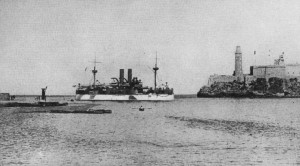One of the primary events leading up to the Spanish-American War (1898) was the sinking of the USS Maine in Havana Harbor.
The USS Maine, was an early pre-dreadnought battle-cruiser. The ship was commissioned in September of 1895 in response to the construction of the Brazilian battleship Riachuelo which, when commissioned in 1883, was the most powerful warship in the Western hemisphere and the first battleship in the world to have a compound armored belt. This was a threat the US Navy could not take lightly; America’s government responded with the construction of the Maine (commissioned 1895) and several other warships.

(Photo # HD-SN-99-01929, courtesy of Defense Visual Information Center).
The Maine had been ordered to Cuba on 24 January 1898 by President William McKinley following the deaths of over 100,000 Cuban citizens resulting from reconcentration policies enacted by Spanish General Valeriano Weyler y Nicolau. McKinley had acted upon the insistent urging of many in Washington, including his Assistant Secretary of the Navy, Theodore Roosevelt.
The battleship arrived on 25 January with orders to be at hand to protect American interests, having steamed from Key West, FL. Spanish authorities in Havana were unsure of American intentions, but they afforded Captain Charles Sigsbee and the crew of Maine every courtesy.
On the evening of 15 February, a terrible explosion on board Maine shattered the forward third of the ship. Later investigations revealed that more than five tons of gunpowder had detonated in the forward magazine. Most of the crew was sleeping in the forward part of the ship when the explosion occurred. Two-hundred sixty men were either killed instantly or trapped below decks as the ship sank. The wreckage rapidly settled to the bottom of the harbor.
Immediately after the explosion Spanish authorities began efforts to rescue survivors; several Spanish soldiers risked their lives in order to pull wounded men off the burning ship as it sank. Owing to this activity, the Captain of the Maine noted in his initial report to Washington that opinions as to the cause of the explosion should not be commented on.
However, a subsequent investigation by four American Naval officers later determined that the outer hull of the ship was bent inwards near where the explosion had taken place. Before the Navy could explain possible reasons for this, the American press publicized that such conditions could only have come from the explosion of a mine or similar act of war on the part of the Spaniards. The Navy grudgingly agreed with the possibility of such a cause, but refused to fix blame on the Spanish.
On 21 April, under intense political pressure, the President ordered the Navy to begin a blockade of Cuba. Spain followed with a declaration of war on 23 April. Two days later, Congress responded in kind. America’s war for empire was on.
Subsequent investigations conducted since the sinking, including some making use of modern technology and expertise, have concluded the most likely cause of the explosion was a fire fueled by coal dust in a storage bunker situated next to the magazine. Still, to this day, the precise cause of the ship’s demise is hotly debated by experts.
The Maine’s wreckage was cleared by the US Army Corps of Engineers in 1912; the remains of 65 sailors still inside were removed and buried at Arlington Cemetery next to a monument containing the ships’ mast. What remained of vessel was disposed of several miles north of the harbor.
— Calen Edgar

 Saving...
Saving...